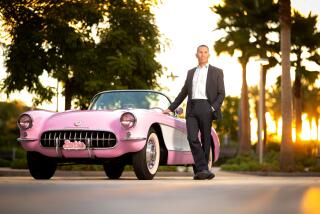Toy Makers Go Gaga Over Electronic Gadgets for Infants
Toy makers are hoping to bring their newest electronic toys to customers who thus far have ignored the computer revolution: babies.
Now they have to convince the under-1-year-old crowd, and the people who buy for them, that tech can add to tots’ play as early as the infant’s first car ride home from the hospital.
The largest toy makers--alongside smaller, specialty manufacturers--are betting big on gizmos for the baby crowd, offering everything from interactive stacking rings to voice-activated stuffed animals and baby computer keyboards.
How big is the trend? About 60% of the new toys unveiled by Mattel Inc.’s Fisher-Price unit come with a computer chip. That’s up from less than 10% only three years ago.
The sellers’ real pitch is to tech-savvy adults, of course, especially doting grandparents and baby boomer moms and dads eager to secure an intellectual advantage with what manufacturers say are educational toys for babies from birth on up.
“It’s not that far of a leap. You have a 1 1/2-year-old playing with a make-believe remote control and cell phone,” said David Miller, the president of the Toy Manufacturers of America and a toy industry veteran. “It’s a reflection of adult life, and that’s what toys have always been. Is it necessary? I don’t know.”
Joyce Hopkins doesn’t think so. Hopkins, an associate professor of psychology at the Illinois Institute of Technology, said that just because the technology is available doesn’t mean children need it.
“I don’t think it’s particularly harmful, but I think it’s totally unnecessary,” said Hopkins, an expert in infant development and parent-baby interaction. “It’s going to encourage parents to feel they need to spend money on these things, and there is no evidence that it’s going to help their child learn more quickly.”
But that didn’t stop toy makers from proudly showing off their “infant electronica” at this year’s annual Toy Fair in New York, when retailers get a first look at thousands of hot holiday toys.
Long-Beach based Neurosmith offered “The Babbler,” a $50 motion-activated soft toy that teaches the language sounds of Spanish, French and Japanese. LeapFrog Toys of Emeryville showed tech toys for children as young as 9 months, including “My First Mouse Pad,” a $15 toy computer accessory, and a $25 frog that teaches colors, body parts and dressing skills.
And with its implicit promise made clear in its name, Colorado-based Baby Einstein Co. this year will offer DVD versions of its Baby Mozart, Baby Bach and Baby Shakespeare tapes.
Giant toy maker Hasbro Inc. showed “Munch and Slurp Teletubbies,” a $25 doll capable of distinguishing among its snacks and “eSpecially My Barney,” a $50 to $60 item that parents can update and personalize by downloading special programs from the Internet.
And Fisher-Price unveiled several items for babies 9 months and older, including “Smartronics” products such as a $30 personal computer keyboard topper for infants to bang and a $15 sorting toy that says shape names, colors and phrases.
For 6-month-olds, the company showed $13 “smart” plush toys that speak and respond, including “Count-With-Me Kitty” and “Alpha-Play Puppy.” Fisher-Price also showed an entertainment unit for car seats, which allows parents to activate music and lights via remote control for babies from birth on up.
Regardless of whether the interactive toys are more fun or better learning tools for infants, they are more likely the first of a trend rather than a one-time fad, toy industry analysts and executives say. As they get older, children’s expectations for what products ought to do will probably increase alongside their parents’ increasing penchant for sophisticated electronic organizers and appliances, those in the industry say.
Traditional toy manufacturers explain that offering tech toys could prove to be an important foothold against newer high-tech companies eager to expand their toy business, such as Neurosmith, which was started by software executives.
What’s more, computing power during the last decade has grown a thousandfold--for about a thousandth of the price, making many interactive toys more accessible than ever.
“The bells, whistles, music and lights, these are things that make the toy more fun to the child,” said Neil Friedman, Fisher-Price’s president. “The reason they weren’t there before isn’t because they weren’t good things, but because they weren’t affordable.”
Still, some of the toys sport prices that many parents might not see as very tot-friendly, such as Neurosmith’s $80 music blocks and a $60 beeping, flashing, talking baby activity table jointly made by Mattel and Microsoft Corp.
The notoriously volatile toy industry, in which gains can be driven by one “hit” toy, has long searched for an electronic gizmo that would combine the latest in lights and sounds with the timeless staying power of Barbie.
Technology, however, changes more rapidly--and expensively--than doll clothes.
For each hit such as Sega’s Dreamcast, last holiday’s hot new video game system, there are many that flopped. Sega’s latest hit was preceded by a colossal miss, the 1995 Saturn system that failed with consumers and game programmers.
The more complex toys also are more likely to confuse parents who have to evaluate store shelves full of dizzying lights and sounds.
“There are lots of products that do so much more than when you first see it,” said Kathee Tesilja, Target Stores top toy buyer. “If you have a great toy and nobody knows what it does, you have a hard time selling it, particularly at these prices.”
That said, even discount stores with toys are likely to stock many of the new, high-price gizmos.
“Parents will spend hundreds of dollars on a PlayStation and its cartridges,” another toy buyer said. “A lot of them will be willing to spend on educational toys.”
More to Read
Inside the business of entertainment
The Wide Shot brings you news, analysis and insights on everything from streaming wars to production — and what it all means for the future.
You may occasionally receive promotional content from the Los Angeles Times.









